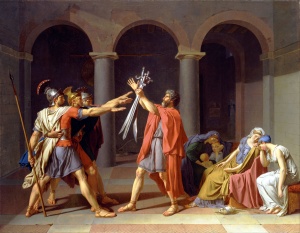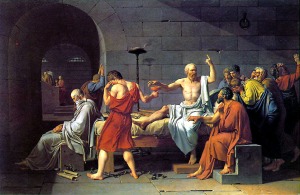Impressionism is defined as an art movement that occurred in the 19th century and was created by a group of Paris-based artists. They had independent exhibitions that brought them up in the art world during the 1870s and 1880s, even though the conventional art community in France did not appreciate their works. The term Impressionism originated with a piece of work by Claude Monet that was called “Impression, soleil levant.” In English, this stands for “Impression, Sunset.” The term came from a critic of Monet’s artwork, who was writing satirically about his art work. The dark painting by Monet was created in 1890-1891. I personally am a fan of Impressionistic art when it is compared to Romantic art.
Impressionism at It’s Finest
The main stylistic features behind impressionism are sketchy lines, loose brush strokes, and dabs of color that blend together. The main subject matter of these paintings was transitory effects of light and weather, the amusements and pastimes of the middle and upper classes, and pleasant moments. Impressionistic pieces of art did not focus on traditional subject matter like history, religion, and classical antiquities; instead it focused on the lighter side of stuff. Personally I prefer this when looking at art and this is one of the main reasons why I truly like this type of paintings over the Romantic paintings. I also found it interesting that the way the painter worked was more important than the painter themselves. This intrigued me, because paintings are almost always judged by their appearance and not by their artist. I also find it interesting that this type of work was at first highly criticized, and only later appreciated. I wonder if the change in artistic properties was too much at that time, so people just could not comprehend the fresh and colorful pieces of work. Another reason I enjoy this art is because it resembles more modern art of this time. I prefer extremely modern art of this era, and Impressionism reminds me more of this than Romanticism. Another piece I enjoyed that was created in 1876 was “Le Moulin de la Galette” by Pierre-Auguste Renoir. I loved how everyone sort of looked similar, and how everyone blended into one another. You could clearly see where each person began and ended, but the lines of each person were foggy, unclear, and sketchy. I also enjoyed how light it was, and how it displayed a pastime of the people in the painting.

Impressionism verse Romanticism
I decided to compare impressionism to Romanticism. I chose Romanticism, because I was not entirely a fan of all of the work, and I found it easy to compare to impressionism. Unlike Impressionism, Romanticism was more subjective and the artists wanted the paintings to elicit emotions and feelings. While impressionistic paintings were more about the process with the artist, Romantic artists used their art to bring out certain emotions. The subject matter of Romantic pieces was quite different from Impressionistic pieces. The Romantic paintings seemed misty, fantastic, exotic, included worlds of dreams, and included fabulous landscapes. They were completely different from the realistic, pastime showing paintings of Impressionism. One specific Romantic piece of artwork that I’m not a fan of is “The Third of May” by Francisco de Goya. The painting was created in 1814 in Spain and is oil on canvas. The image depicts random executions of the Spanish people that resulted in the fighting in the Puerto del Sol area of Madrid. I don’t like that the paintings showed horrible tragedies or injustices, even if they were to create emotion from the viewer. It just seems much sadder than the light colorful pieces from the Impressionism era.
Modern Comparisons
Another type of painting genre is contemporary art. Contemporary art constitutes art that was created after the 1970’s. Contemporary art is generally defined as art that is created within our current lifetime. With this art, there are lots of bright colors and many of the paintings seem random and obscure. I was searching around on the web and found a website that featured exhibits of a few artists. I found one artist that I really like. Her name is Corrine Wasmuht and her venue was at Johann Koenig, Berlin. The venue featured from September 19th to November 1, 2014. The set of paintings were completely different from Impressionistic art. While Impressionism showed lots of outdoors pictures, and was very colorful, Wasmuht’s paintings seemed to show a bunch of different scenes in one picture. Wasmuht’s paintings were made to display the properties of light and space, quite unlike Impressionistic pieces. I found that both types of art seem very modern and fresh compared to most art in the past. The one thing I found to be different was that this contemporary art was created to entice you to think about what is happening, unlike the simplistic Impressionism art. Wasmuht planned for her audience to think about space and light, and how the dissolution of time and space has proceeded. I greatly preferred Wasmuht’s paintings over Impressionistic art. Wasmuht had the similar modern aspect to it as Impressionism had had, but her art also had a thinking aspect. This intrigues me, and is the main reason why I generally like Contemporary Art over Impressionistic art.

References:
Weems, Erik E. Soya. The Third of May. 2006. October 24, 2014. http://eeweems.com/goya/3rd_of_may.html
Corrine Wasmuht at Johann Koenig. Contemporary Art Daily. Published October 26th, 2014. Accessed October 10, 2014. http://www.contemporaryartdaily.com/2014/10/corinne-wasmuht-at-johann-ko%CC%88nig/
Romanticism. Wikipedia. October 25, 2014. Accessed October 26, 2014. http://en.wikipedia.org/wiki/Romanticism
Impressionism. Wikipedia. October 25, 2014. Accessed October 26, 2014. http://en.wikipedia.org/wiki/Impressionism
Contemporary Art. Wikipedia. October 25, 2014. Accessed October 26, 2014. http://en.wikipedia.org/wiki/Contemporary_art


